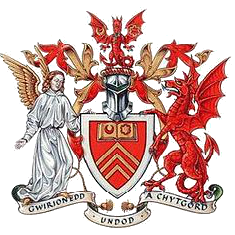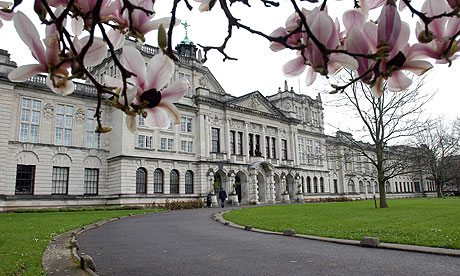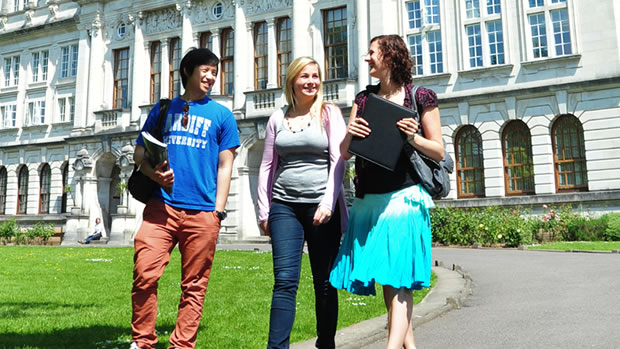Cardiff University:
Cardiff University (Welsh: Prifysgol Caerdydd) is a public research university located in Cardiff, Wales, United Kingdom. The University is composed of three colleges: Arts, Humanities and Social Sciences; Biomedical and Life Sciences; and Physical Sciences and Engineering.
Founded in 1883 as the University College of South Wales and Monmouthshire, it becam
e one of the founding colleges of the University of Wales in 1893, and in 1999 became an independent University awarding its own degrees. It is the second oldest university in Wales. It is a member of the Russell Group of leading British research universities.The university is consistently recognised as providing high quality research-based university education and is ranked 123 of the world’s top universities by the QS World University Rankings, as well as achieving the highest student satisfaction rating in the 2013 National Student Survey for universities in Wales.
The University has an undergraduate enrollment of 20,611 and a total enrollment of 27,774, making it one of the largest universities in Wales. The Cardiff University Students’ Union works to promote the interests of the student body within the University and further afield. The University’s sports teams compete in the British Universities and Colleges Sport (BUCS) leagues.
History
Discussions regarding the founding of a college in South Wales began as early as 1879, when a group of Welsh and English MPs urged the government to consider the poor provision of higher and intermediate education in Wales and ‘to consider the best means of assisting any local effort which may be made for supplying such deficiency’.
In October 1881 Gladstone’s government appointed a departmental committee to conduct ‘an enquiry into the nature and extent of intermediate and higher education in Wales’. The committee was chaired by Lord Aberdare and consisted of Viscount Emlyn, Reverend Prebendary H. G. Robinson, Henry Richard, John Rhys and Lewis Morris.[6] The Aberdare report, as it came to be known, took evidence from a wide range of sources and over 250 witnesses and recommended a college for North and South Wales each, the southern to be located in Glamorgan and the Northern to be the already established University College of Wales in Aberystwyth (now Aberystwyth University). The committee cited the unique Welsh national identity and that many students in Wales could not afford to travel to University in England or Scotland. Furthermore it advocated for a national degree-awarding university for Wales, composed of the regional colleges. It also recommended that the colleges should be unsectarian in nature and that they should exclude the teaching of theology.
After this recommendation was published the Cardiff Corporation attempted to secure the location of the college as Cardiff, and on 12 December 1881 formed a University College Committee to aid the matter.A competition arose between Swansea and Cardiff about where the college should be located and on the 12th March 1883, after a period of arbitration, the location was set as Cardiff.The case for Cardiff was strengthened by stressing the need to take account of the interests of Monmouthshire, at that time not legally considered part of Wales, as well as the greater sum of money received by Cardiff in support of the college, through a public appeal that raised £37,000, and a number of private donations, notably from the Lord Bute and Lord Windsor.[9][10] In April Lord Aberdare was appointed as the College’s first president.The possible locations considered for the college included Cardiff Arms Park, Cathedral Road or Moria Terrace, Roath, before the site of the Old Royal Infirmary buildings on Newport Road were chosen.
The University College of South Wales and Monmouthshire opened on 24 October 1883, offering studies in Biology, Chemistry, English, French, German, Greek, History, Latin, Mathematics & Astronomy, Music, Welsh, Logic & Philosophy and Physics. The University College was incorporated by Royal Charter the following year, this charter was the first in Wales to allow the enrollment of women, and specifically forbid religious tests for entry.[10] John Viriamu Jones was appointed as the University’s first Principal, at age 27. As Cardiff was not an independent university and could not award its own degrees, it prepared its students for the examinations of the University of London or further study at Oxford or Cambridge.
In 1888 the university college at Cardiff and University College of North Wales (now Bangor University) proposed to University College Wales (at Aberystwyth) a joint action to obtain a university charter for Wales, modeled on that of Victoria University, a confederation of new universities in Northern England. This charter was granted to the new University of Wales in 1893, allowing the colleges to award degrees as members of this institution. The chancellor was set ex officio as the Prince of Wales, and the position of operational head would rotate among heads of the colleges.In 1885, Aberdare Hall opened as the first hall of residence, allowing women access to the university. This moved to its current site in 1895, but remains a single-sex hall. 1904 saw the appointment of the first female professor in the UK, Millicent McKenzie.
Organisation and academic profile
Schools and colleges
The 27 academic schools of the University are divided into three colleges: Arts, Humanities and Social Sciences; Biomedical and Life Sciences; and Physical Sciences.
College of Arts, Humanities and Social Sciences
|
College of Biomedical and Life Sciences
|
College of Physical Sciences
|
Cardiff also has a University Graduate College that brings together the work of four previous discipline-based Graduate Schools and the postgraduate research activity of the University’s Graduate Centre.


